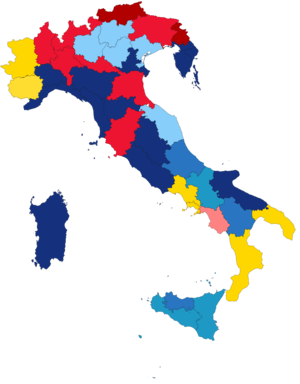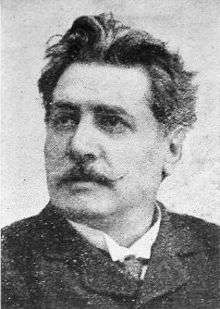1921 Italian general election
General elections were held in Italy on 15 May 1921.[1] It was the first election in which the recently acquired regions of Trentino-Alto Adige, Venezia Giulia, Zara and Lagosta island elected deputies, many of whom from Germanic and South Slav ethnicity.[2]
| |||||||||||||||||||||||||||||||||
All 535 seats to the Chamber of Deputies of the Kingdom of Italy | |||||||||||||||||||||||||||||||||
|---|---|---|---|---|---|---|---|---|---|---|---|---|---|---|---|---|---|---|---|---|---|---|---|---|---|---|---|---|---|---|---|---|---|
| |||||||||||||||||||||||||||||||||

PSI PPI BN PLD PLI PDSI PDR SeT | |||||||||||||||||||||||||||||||||
| |||||||||||||||||||||||||||||||||
Historical background
From 1919 to 1920 Italy was shocked by a period of intense social conflict following the First World War; this period was named Biennio Rosso (Red Biennium).[3] The revolutionary period was followed by the violent reaction of the Fascist blackshirts militia and eventually by the March on Rome of Benito Mussolini in 1922.
The Biennio Rosso took place in a context of economic crisis at the end of the war, with high unemployment and political instability. It was characterized by mass strikes, worker manifestations as well as self-management experiments through land and factories occupations.[3] In Turin and Milan, workers councils were formed and many factory occupations took place under the leadership of anarcho-syndicalists. The agitations also extended to the agricultural areas of the Padan plain and were accompanied by peasant strikes, rural unrests and guerrilla conflicts between left-wing and right-wing militias.
In the general election of 1921, the Liberal governing coalition, strengthened by the joining of Fascist candidates in the National Blocs (33 of whom were elected deputies), came short of a majority. The Italian Socialist Party, weakened by the split of the Communist Party of Italy, lost many votes and seats, while the Italian People's Party was steady around 20%. The Socialists were stronger in Lombardy (41.9%), than in their historical strongholds of Piedmont (28.6%), Emilia-Romagna (33.4%) and Tuscany (31.0%), due to the presence of the Communists (11.9, 5.2 and 10.5%), while the Populars were confirmed the largest party of Veneto (36.5%) and the Liberal parties in most Southern regions.[4]
Parties and leaders
| Party | Ideology | Leader | |
|---|---|---|---|
| Italian Socialist Party (PSI) | Socialism, Revolutionary socialism | Giovanni Bacci | |
| Italian People's Party (PPI) | Christian democracy, Popularism | Luigi Sturzo | |
| National Blocs (BN) | Italian nationalism, Anti-socialism | Giovanni Giolitti | |
| Democratic Liberal Party (PLD) | Liberalism, Radicalism | Francesco Saverio Nitti | |
| Italian Liberal Party (PLI) | Liberalism, Centrism | Luigi Facta | |
| Social Democratic Party (PDSI) | Social liberalism, Radicalism | Giovanni Antonio Colonna | |
| Communist Party of Italy (PCdI) | Communism, Marxism-Leninism | Amedeo Bordiga | |
| Italian Republican Party (PRI) | Republicanism, Radicalism | Eugenio Chiesa | |
| Reformist Democratic Party (PDR) | Reformism, Social democracy | several | |
| Combatants' Party (PdC) | Italian nationalism, Veteran interests | several | |
Coalitions
| Coalition | Parties | ||
|---|---|---|---|
| Italian People's Party (PPI) | |||
| National Blocs (BN) | |||
| Democratic Liberal Party (PLD) | |||
| Italian Liberal Party (PLI) | |||
| Social Democratic Party (PDSI) | |||
| Combatants' Party (PdC) | |||
| Italian Socialist Party (PSI) | |||
| Communist Party of Italy (PCdI) | |||
| Italian Republican Party (PRI) | |||
| Reformist Democratic Party (PDR) | |||
Results
 | |||||
| Party | Votes | % | Seats | +/− | |
|---|---|---|---|---|---|
| Italian Socialist Party | 1,631,435 | 24.7 | 123 | −33 | |
| Italian People's Party | 1,347,305 | 20.4 | 108 | +8 | |
| National Blocs | 1,260,007 | 19.1 | 105 | New | |
| Democratic Liberal Party | 684,855 | 10.4 | 68 | −28 | |
| Italian Liberal Party | 470,605 | 7.1 | 43 | +2 | |
| Italian Social Democratic Party | 309,191 | 4.7 | 29 | −31 | |
| Communist Party of Italy | 304,719 | 4.6 | 15 | New | |
| Italian Republican Party | 124,924 | 1.9 | 6 | −3 | |
| Reformist Democratic Party | 122,087 | 1.8 | 11 | New | |
| Combatants' Party | 113,839 | 1.7 | 10 | −10 | |
| Lists of Slavs and Germans | 88,648 | 1.3 | 9 | New | |
| Economic Party | 53,382 | 0.8 | 5 | −2 | |
| Independent Socialists | 37,892 | 0.6 | 1 | ±0 | |
| Dissident Populars | 29,703 | 0.4 | 0 | New | |
| Italian Fasci of Combat | 29,549 | 0.4 | 2 | New | |
| Invalid/blank votes | 93,355 | – | – | – | |
| Total | 6,701,496 | 100 | 535 | +27 | |
| Registered voters/turnout | 11,477,210 | 58.4 | – | – | |
| Source: Ministry of National Economy | |||||
Deputies elected by Region
| Region | PSI | PPI | PLD | PDS | FIC | PE | PSRI | PLI | PCd'I | ANI | SeT | PRI | PSdA | PdC | SI |
|---|---|---|---|---|---|---|---|---|---|---|---|---|---|---|---|
| Piedmont | 16 | 12 | 13 | 1 | 3 | 4 | – | 1 | 5 | 1 | – | – | – | – | – |
| Liguria | 4 | 5 | 2 | 1 | 2 | – | – | – | 1 | 1 | – | – | – | – | 1 |
| Lombardy | 27 | 19 | 1 | 4 | 5 | 3 | 1 | 3 | 1 | – | – | – | – | – | – |
| Veneto | 17 | 19 | 2 | 3 | 4 | 1 | 1 | 1 | – | – | – | 1 | – | – | – |
| Emilia-Romagna | 14 | 8 | 4 | 1 | 7 | 2 | – | – | 2 | – | – | 2 | – | – | – |
| Tuscany | 12 | 8 | 4 | 2 | 4 | 2 | 1 | 2 | 3 | – | – | 1 | – | – | – |
| Marche | 4 | 5 | 2 | 1 | 1 | 2 | – | – | 1 | – | – | 1 | – | – | – |
| Umbria | 3 | 1 | 1 | 2 | 2 | 1 | – | – | – | – | – | – | – | – | – |
| Lazio | 4 | 3 | 2 | – | 1 | 1 | – | – | – | 3 | – | 1 | – | – | – |
| Abruzzi | 3 | 1 | 6 | 3 | 2 | – | 1 | 1 | – | 1 | – | – | – | – | – |
| Campania–Molise | 4 | 9 | 16 | 18 | – | – | 6 | 2 | – | 2 | – | – | – | 2 | – |
| Apulia | 6 | 2 | 10 | 4 | 1 | 3 | – | 2 | – | – | – | – | – | – | – |
| Basilicata | 1 | – | 4 | 1 | – | 1 | 3 | – | – | – | – | – | – | – | – |
| Calabrie | 2 | 3 | 7 | 5 | – | 1 | 3 | – | – | 1 | – | – | – | – | – |
| Sicily | 4 | 7 | 7 | 17 | – | 6 | 8 | 2 | – | 1 | – | – | – | – | – |
| Sardinia | 1 | 1 | 4 | 2 | – | – | – | – | – | – | – | – | 4 | – | – |
| Venezia Tridentina | 2 | 5 | – | – | – | – | – | – | – | – | 4 | – | – | – | – |
| Venezia Giulia | – | – | – | – | 4 | – | 1 | 3 | 2 | 1 | 5 | – | – | – | – |
| Italy | 124 | 108 | 85 | 65 | 36 | 27 | 25 | 17 | 15 | 11 | 9 | 6 | 4 | 2 | 1 |
References
- Dieter Nohlen & Philip Stöver (2010) Elections in Europe: A data handbook, p1047 ISBN 978-3-8329-5609-7
- ITALY’S FRINGE OF ALIEN SUBJECTS, The New York Times, May 29, 1921
- Brunella Dalla Casa, Composizione di classe, rivendicazioni e professionalità nelle lotte del "biennio rosso" a Bologna, in: AA. VV, Bologna 1920; le origini del fascismo, a cura di Luciano Casali, Cappelli, Bologna 1982, p. 179.
- Piergiorgio Corbetta; Maria Serena Piretti, Atlante storico-elettorale d'Italia, Zanichelli, Bologna 2009


.png)